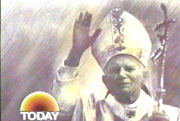The Life of Pope John Paul:
Table of Contents:
Executive Summary
 As in last year’s coverage of the death of President Ronald Reagan,
the national media offered Pope John Paul II a generous farewell,
highlighting his positive role in ending the Cold War, building bridges
to other faiths, and inspiring Catholics in his energetic travels. But
the positive coverage did not match the usual pattern of papal coverage
over the decades of his pontificate (1978-2005). In the typically
secular and political approach of the networks, John Paul was portrayed
during his life as positive or negative depending on whose political
side he landed on. On internal church matters over the years, reporters
glorified and enlarged the influence of those who wanted to invent a
more convenient church that defines holiness down for its members, not
preserve an ancient church and call its members to greater commitment.
Trends in papal coverage included:
As in last year’s coverage of the death of President Ronald Reagan,
the national media offered Pope John Paul II a generous farewell,
highlighting his positive role in ending the Cold War, building bridges
to other faiths, and inspiring Catholics in his energetic travels. But
the positive coverage did not match the usual pattern of papal coverage
over the decades of his pontificate (1978-2005). In the typically
secular and political approach of the networks, John Paul was portrayed
during his life as positive or negative depending on whose political
side he landed on. On internal church matters over the years, reporters
glorified and enlarged the influence of those who wanted to invent a
more convenient church that defines holiness down for its members, not
preserve an ancient church and call its members to greater commitment.
Trends in papal coverage included:
The “Communist Pope”? During his life and after his death, reporters and pundits alike acknowledged Pope John Paul’s political triumph in opposing Soviet communism. But over the years, several liberal media accounts portrayed Pope John Paul as comparable to (or even inferior to) a communist dictator during his reign at the Vatican.
John Paul vs. Conservatism: While the media protested the conservative influence of the Pope John Paul and the bishops on sexual issues, sometimes as a grievous invasion of the Church upon the State, when the Pope sounded a note more pleasing to liberals, suddenly his influence was lauded as a voice of booming moral authority against conservatives.
Liberals vs. John Paul: Reporters who see themselves as advocates for democracy and modernity found Pope John Paul lacking in both during his tenure, insisting that he needed to stop his fuddy-duddy conservative opposition to the sexual revolution, look at the public opinion polls and get with the times, especially to keep parishioners inside the Catholic churches of America.
“Catholics” vs. Catholicism: When discussing the urge for potential “reform” of the church during the last quarter-century, the secular media demanded religion-by-ballot, with no room for sacred traditions, and no awe for an “authoritarian” God. Reporters glorified and enlarged the influence of John Paul’s opponents, constantly lobbying for what they called the “many Catholics” who wanted to attack the traditions and teachings of the faith.
The report concludes that in all the attention the media will pay to the selection of a new pope, it should keep in mind that their coverage of the church should be designed to present a fair and accurate picture of the proceedings without putting their thumb on the scale in an attempt to invent a Catholic church more in tune with secular journalists.



